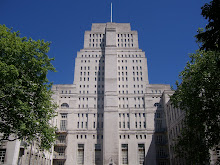
As Beveridge’s well-worn anecdote regarding the cab-driver and the Royal School of Needlework demonstrates, throughout the early twentieth-century there was a need to impress the University of London onto the cognitive maps of even the most cartographically astute Londoners. Consequently, a key aspect of the brief for Senate House involved constructing a tower that would establish the institution as a presence on the capital’s skyline. A decade or so later this desire for a notable landmark would inadvertently provide a useful guide for the Luftwaffe during their lethal bombing raids (leading to the oft-repeated urban myth that Hitler had favoured Senate House as a potential Nazi command post).
No architectural competition was held for Senate House. After the initial selectors shuffled through the remnants of a rather Edwardian directory to hedge their bets with fourteen possible architects, the final committee nominated a new short-list of four: Giles Gilbert Scott; Arnold Dunbar Smith; Percy Scott Worthington; Charles Holden. A combination of factors steered the selectors towards Holden. Championed by Beveridge from inside the committee and given influential external support by Frank Pick, Holden was the only candidate to bring preliminary sketches to the series of black-tie dinners held for each finalist at the Athenaeum. He had also recently designed 55 Broadway as the new tower-topped HQ for a rapidly expanding and modernizing London Underground. Completed in 1929 on a restricted site near St James’s Park, the dexterously monumental building not only proved that Holden could manage a large scale project but also suggested that he would bring to the design of Senate House a palatable modernity capable of communicating the progressive momentum of the University.
Holden was not the only short-listed candidate with a proven track record in designing towers. In 1903, at the tender age of 22, Giles Gilbert Scott had won the competition to design Liverpool Cathedral. Scott’s reputation rose alongside the cathedral as it began to take shape over the rooftops of Hope Street – albeit with his own telling redesign that replaced the original plan for twin towers with a massive central tower. A scion of a prolific architectural dynasty, Scott had the highest public profile on the Senate House short-list. A series of inter-war church commissions had made him one of the most sought after ecclesiastical architects of the period. Yet for those with a penchant for counterfactuals, it is the educational and industrial structures that Scott’s small office handled that encourages speculation on the likely form of his unbuilt tower for Senate House.
South London has offered fertile ground for Scott’s skyscraping landmarks. After construction had begun on J. Theo Halliday’s design for Battersea Power Station in 1929, Scott was brought in as consultant architect to finesse the detailing of the titanic brickwork exterior and chimneys. In 1932 he finished the William Booth Memorial Training College, another extended essay in brick with a massive tower that looms over the lost souls of Denmark Hill (shortly afterwards he completed the similarly monolithic ‘dark tower’ of Cambridge University Library – celebrating its 75th anniversary this month). A much later work than any of these is Bankside Power Station, designed by Scott a few miles downriver from the Battersea matrix.
As Cedric Price astutely observed, the slender square tower of Bankside (now glowingly Tate Modernized) sticks a brickwork middle finger up to St Paul’s Cathedral across the water. Could this have been an unconscious gesture of spiritual defiance from a Catholic architect who had intermittently spent his entire adult life attempting to terminate an Anglican edifice? Could the affable GG Scott have secretly been a repressed GG Allin of architecture? Or was that middle finger more emblematic of the unconvincing ‘middle line’ that Scott insisted on navigating between such phantom monoliths as modernism and tradition? (Rather than an answer to these questions, a neighbourly aside suddenly springs to mind: it should be noted that for almost forty years Cedric Price’s innovative architectural office operated just beyond Senate House on the corner of Alfred Place and Store Street.)
For those who find themselves in the shadow of Senate House there is a far easier way to visualize a possible version of what Scott’s tower would have looked like. It takes the form of the K6 phone-box located on the Malet Street side of the south block of Senate House itself. Mass-produced in 1936 as a more economic variant of the K2, the famously Soane-inspired kiosk was first sketched by Scott in the mid-1920s after he had been appointed a trustee of the Soane museum. During August of this year the Malet Street phone-box was given what appeared to be a sub-Sophie Calle makeover. Although I used to walk down Malet Street almost every morning, by the time I had registered the continued presence of a folding chair, cushions, and blanket inside the phone-box, the accompanying message handwritten on sheets of paper stuck to the kiosk’s rectangular glass panels had faded into illegibility.

William Beveridge was a remarkably astute propagandist as well as a silky smooth bureaucrat. The anecdote is a "half-truth" about how obscure the former location was.
ReplyDeleteIn 1899 the University of London had moved out of its former home in Burlington Gardens behind the Royal Academy (more recently remembered as The Museum of Mankind) into the vacant space within the Imperial Institute - the Government had bailed out that institution without a purpose a few years earlier.
Colcutt's Imperial Institute building had a 287 foot high tower - still standing as Queens Tower in the middle of the Imperial College campus.
As London cabbies have never been noted for looking up at the skyline, I have a sneaking suspicion that the Royal School of Needlework (on the corner of Exhibition Road and Imperial Institute Road) was on "The Knowledge" and remembered whereas Imperial Institute wasn't.
情人節|伊莉,情趣商品,情色文學,
ReplyDeleteG點,按摩棒,轉珠按摩棒,變頻跳蛋,跳蛋,無線跳蛋,
飛機杯,男用強精長軟質套,男用強精短軟質套,充氣娃娃,男性性感內褲,性感內褲,
自慰套,自慰套,情趣娃娃,自慰器,電動自慰器,充氣娃娃,
角色扮演,角色扮演服,
性感睡衣,情趣睡衣,性感內衣褲,性感內衣,內衣,性感內褲,C字褲,內褲,
性感貓裝,性感睡衣,貓裝,吊帶襪,情趣內褲,丁字褲,SM道具,SM,
震動環,潤滑液,情趣禮物,情趣玩具,威而柔,精油,逼真按摩棒,數位按摩棒,
情趣加盟,情趣,情趣用品,巴黎,